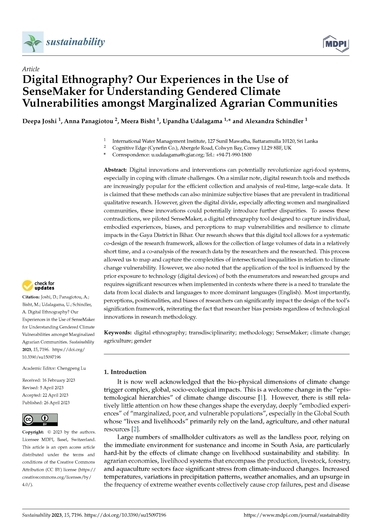Digital ethnography? Our experiences in the use of SenseMaker for understanding gendered climate vulnerabilities amongst marginalized agrarian communities
Abstract
Digital innovations and interventions can potentially revolutionize agri-food systems, especially in coping with climate challenges. On a similar note, digital research tools and methods are increasingly popular for the efficient collection and analysis of real-time, large-scale data. It is claimed that these methods can also minimize subjective biases that are prevalent in traditional qualitative research. However, given the digital divide, especially affecting women and marginalized communities, these innovations could potentially introduce further disparities. To assess these contradictions, we piloted SenseMaker, a digital ethnography tool designed to capture individual, embodied experiences, biases, and perceptions to map vulnerabilities and resilience to climate impacts in the Gaya District in Bihar. Our research shows that this digital tool allows for a systematic co-design of the research framework, allows for the collection of large volumes of data in a relatively short time, and a co-analysis of the research data by the researchers and the researched. This process allowed us to map and capture the complexities of intersectional inequalities in relation to climate change vulnerability. However, we also noted that the application of the tool is influenced by the prior exposure to technology (digital devices) of both the enumerators and researched groups and requires significant resources when implemented in contexts where there is a need to translate the data from local dialects and languages to more dominant languages (English). Most importantly, perceptions, positionalities, and biases of researchers can significantly impact the design of the tool’s signification framework, reiterating the fact that researcher bias persists regardless of technological innovations in research methodology.

